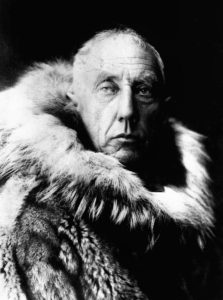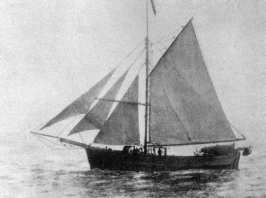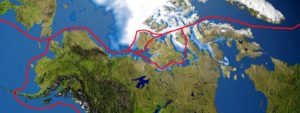The Northwest Passage—a sea route across the Arctic region between the Atlantic and Pacific Oceans—had been a dream for centuries. It became a reality in 1905 when Norwegian explorer Roald Amundsen completed the journey. Today, climate change has made what was once a dream into a certainty.
The mariners who tried to find the Northwest Passage reads like a who’s who of explorers. Christopher Columbus, John Cabot, Henry Hudson, James Cook, James Franklin and, finally and successfully, Roald Amundsen. Amundsen lived from 1872 to 1928 and conducted many polar expeditions. His most famous was his traverse of the Northwest Passage, which occurred from 1903 to 1906.

He had studied other attempts to cross the Arctic Sea, all of which ended in failure. He decided to try another tactic, using a small fishing ship, the Gjoa (70 feet long, but with a very shallow draft), and a small crew (seven men) that would allow flexibility and access to shallow waters. They left the southern coast of Greenland in summer of 1903 and picked their way through the ice up, across and down Baffin Island and somewhat farther west, stopping at King William Island. There, at a protected bay they named Gjoa Haven, they stayed for two years, learning survival skills from the native Inuits, taking scientific measurements and searching for the magnetic North Pole.

On August 13, 1905, they set sail again, heading west through narrow and shallow straits. A few days later, they encountered a whaling ship headed east, and Amundsen knew he had completed his quest. As he wrote in his diary, “The North West Passage was done. My boyhood dream—at that moment it was accomplished. A strange feeling welled up in my throat; I was somewhat over-strained and worn—it was weakness in me—but I felt tears in my eyes. ‘Vessel in sight… Vessel in sight.’” They were soon iced-in again and spent another winter before landing at Nome, Alaska, the following August (perhaps on August 13 again, but I can’t confirm the date).
Amundsen’s achievement was world news, but it had little practical impact. He used routes too shallow for commercial vessels and spent years to accomplish the journey. Various other voyages, using modern ice-breaking ships, managed to make the journey in recent decades, but those outcomes were still novelties.
Climate change, however, is changing all that. The Arctic region is warming much faster than the rest of the world, taking sea ice with it. Arctic sea ice has dropped by about 1.3% per year since the 1970s. An ice-free passage between the Atlantic and Pacific opened for the first time in history in 2007.

Commercial ship travel has begun, with a still-modest record of 30 ships making the transit in 2012. In 2016, a luxury cruise ship, the Crystal Serenity, made the trip from Alaska to New York, charging up to $50,000 for a stateroom. The increase in commerce raises many questions about the future of the Arctic. Increased exploitation of oil, minerals, forests and wildlife is likely. A legal fight over ownership is developing between Canada, through whose territory any Northwest Passage route will flow, and other Arctic nations, who claim joint sovereignty of the region through treaties.
Ecological impacts are also likely as the climate warms and the ice continues to melt. Migration of species between the oceans will occur—gray whales from the Pacific have recently been seen in the north Atlantic. The poor condition of individual polar bears, which rely on sea ice as their primary habitat, has been broadly reported, but the impact on populations of polar bears remains unknown because of scarce data.
References:
ArcGIS. Roald Amundsen Northwest Passage Map. Available at: https://www.arcgis.com/home/webmap/viewer.html?webmap=605b5c99c1ad42678ddfa6b1d47cbc7d. Accessed June 15, 2018.
History.com Northwest Passage. Available at: https://www.history.com/topics/northwest-passage. Accessed June 15, 2018.
Kahn, Brian. 2016. This Is What the Ice-Free Northwest Passage Looks Like. Climate Central, August 23, 2016. Available at: http://www.climatecentral.org/news/ice-free-northwest-passage-20624. Accessed June 15, 2018.
King, Hobart M. What is the Northwest Passage? Geology.com. Available at: https://geology.com/articles/northwest-passage.shtml. Accessed June 15, 2018.
Royal Museums Greenwich. Roald Amundsen North-West Passage expedition 1903-1906. Available at: https://www.rmg.co.uk/discover/explore/roald-amundsen-north-west-passage-expedition-1903%E2%80%9306. Accessed June 15, 2018.
